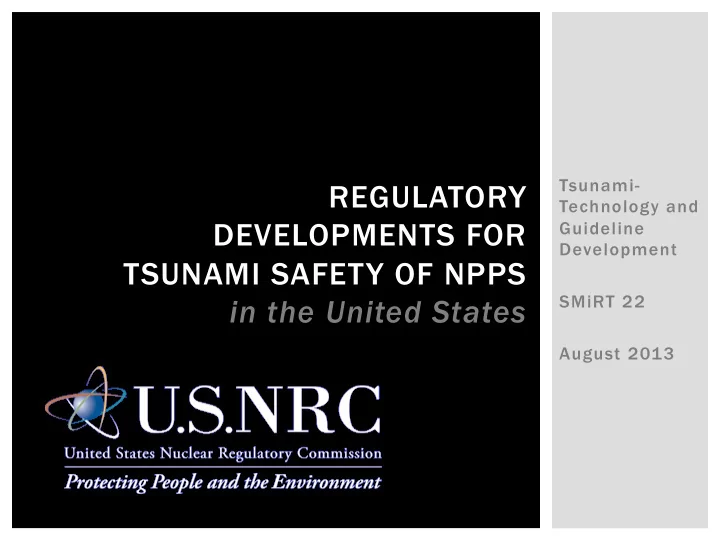

DEVELOPMENT OF Tsunami- REGULATORY REGULATORY Technology and DEVELOPMENTS FOR Guideline Development TSUNAMI SAFETY OF NPPS SMiRT 22 in the United States August 2013
OVERVIEW ¡ Tsunami regulations and regulatory guidance ¡ Objective and outcomes of the NRC tsunami research program ¡ Post-fukushima guidance in support of the 50.54(f) letter ¡ New PFHA activities (Chronological order)
US COASTAL NPPS Ø 2 Pacific Coast Sites • 4 units • 2 units closing Ø 2 Gulf Coast Sites • 3 units Ø 11 Atlantic Coast Sites • 18 units
HAZARD ASSESSMENT AND DESIGN FOR NPPS ¡ US documents addressing hazard assessment, design, and risk assessment are available ¡ Tsunami hazard assessments are site-specific. There is no minimum value. A hierarchical approach is used ¡ Generally (but not always) the flooding from hurricane storm surge exceeds the flooding expected from a tsunami for plants on the Atlantic and Gulf Coast ¡ The PRA Standard (ASME/ANS-Ra-Sa2009) addresses technical requirements for both seismic events and tsunamis (tsunami hazard under the technical requirements for external flooding analysis)
CODE REQUIREMENTS FOR HAZARD ASSESSMENT FOR NPPS ¡ General Design Criterion 2 (GDC 2), 10CFR50, requires, in part, that structures, systems, and components important to safety be designed to withstand the effects of natural phenomena such as floods, tsunami, and seiches without loss of capability to perform their safety functions. ¡ 10 CFR 100.23, requires, in part, that the size of seismically induced floods and water waves that could affect a site from either locally or distantly generated seismic activity must be determined.
HISTORY OF THE TSUNAMI HAZARD GUIDANCE FOR NPPS § RG 1.59 (1977), “Design Basis Floods for Nuclear Power Plants noted the need for tsunami assessments” § RG 1.102 (1976) “Flood Protection for Nuclear Power Plants”
2004 EARTHQUAKE & TSUNAMI
NRC EARLY TSUNAMI ASSESSMENT ACTIVITIES • NRC initiated an Tsunami Technical Advisory Group to determine need for new tsunami hazard assessment guidance. • A tsunami research program was developed in 2005 in response to a User Need Research Request issued to the Office of Research from the licensing offices for new and operating reactors.
OBJECTIVE OF THE NRC TSUNAMI RESEARCH PROGRAM • Provide Tsunamigenic Source Characterization for all key sources • Near-field and Far-field sources • Seismic and Landslide-based sources • Deterministic and probabilistic parameters include source geometry, orientation, size, return period, etc. • Provide approaches for initiation, propagation, and inundation numerical modeling and related assessments • Provide technical support for deterministic & probabilistic hazard assessments for proposed and existing plants • Develop the technical basis for hazard assessment guidance including assessment approaches & modeling tools • Issue new Regulatory Guidance
TSUNAMI HAZARD GUIDANCE FOR NPPS ¡ In response to the Indian Ocean Tsunami, the NRC supported work to develop three new reports. § NOAA Technical Memorandum OAR PMEL-136 (2007), “Scientific and Technical Issues in Tsunami Hazard Assessment of Nuclear Power Plant Sites” § NUREG/CR-6966 (2008), “Tsunami Hazard Assessment Nuclear Power Plants Sites in the US” by PNNL § NOAA also produced PMEL-135 (2007) “Standards, criteria, and procedures for NOAA evaluation of tsunami numerical models”
TSUNAMI HAZARD GUIDANCE FOR NPPS ¡ NUREG-0800 (2007), “Standard Review Plan for the Review of Safety Analysis Reports for Nuclear Power Plants (LWR [light-water reactor] Edition)”, updated in preparation for new NPP applications ¡ Section 2.4.6 is “Probable Maximum Tsunami Flooding”
TSUNAMI HAZARD GUIDANCE & RESEARCH RESULTS ¡ USGS (2007) Report on all potentially tsunamigenic sources in Atlantic & Gulf coasts (both seismogenic & landslide) ¡ Updated (2008) USGS Report, “Evaluation of Tsunami Sources with the Potential to Impact the U.S. Atlantic and Gulf Coasts: an updated Report to the Nuclear Regulatory commission” used by licensees and NRC staff reviewing new NPP applications ¡ Results also published in a special issue of Marine Geology
TSUNAMI HAZARD GUIDANCE & RESEARCH RESULTS ¡ Significant increase in understanding of landslide distribution & mechanisms on US Atlantic & Gulf coasts ¡ Increase in understanding of important parameters of characterization and modeling
TSUNAMI HAZARD GUIDANCE & RESEARCH RESULTS ¡ Example of NRC use of USGS landslide data for licensing review. Modeling performed by Prof. Lynett of USC in conjunction with USGS.
TSUNAMI HAZARD RESEARCH RESULTS ¡ NOAA coupled the iSale impact code with the global model and the source parameters in the USGS Report to assess hazard on the US Atlantic coast from a Canary Islands flank failure and other major Atlantic sources ¡ Results were provided in a report to the NRC and were published by NOAA
HAZARD GUIDANCE FOR NPPS ¡ NRC staff also contributed to IAEA 2011 guidance for hydrological hazards ¡ Appendix II “Current Practice in Some States,” also included information on the practice in the US and Japan
PROBABILISTIC TSUNAMI HAZARD ASSESSMENT RESEARCH ¡ NRC continues to work on PTHA (&PFHA) methods ¡ NRC/USGS Workshop on Landslide Tsunami Probability held 2011 ¡ Tsunami session in 2013 NRC- sponsored Probabilistic Flooding Hazard Assessment workshop ¡ Efforts to develop guidance/ training on applying the SSHAC guidelines (NUREG 2117and NUREG/CR-6372) to PFHA
2011 EARTHQUAKE & TSUNAMI
NTTF RECOMMENDATION 2.1 GUIDANCE DOCUMENTS ¡ In support of the 50.54(f) Request for Information responses (for NTTF Recommendation 2.1) § JLD-ISG-2012-06 (2012), “Guidance for Performing a Tsunami, Surge, or Seiche Hazard Assessment.” ( Tsunami assessment guidance is provided, but limited.) § JLD-ISG-2012-05 (2012), “Guidance for Performing the Integrated Assessment for External Flooding”
ONGOING TSUNAMI ACTIVITIES ¡ Continued development of technical basis for regulatory guidance ¡ Development of new NRC regulatory guidance for tsunami hazard assessment planned ¡ Development of probabilistic methods for PTHA (with integration into PFHA) ¡ Support of work at IAEA on Tsunami PSA ¡ Post-Fukushima 50.54(f) activities in flooding reevaluation for operating NPPs ¡ New reactor licensing
THANK YOU FOR YOUR KIND ATTENTION
Recommend
More recommend